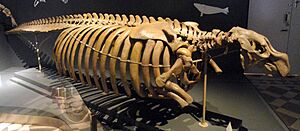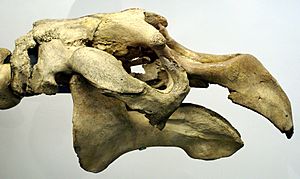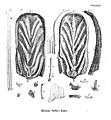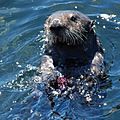Steller's sea cow facts for kids
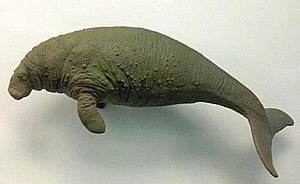
The 'Steller's sea cow (scientific name: Hydrodamalis gigas) was a very large, gentle marine mammal that lived in the cold waters of the North Pacific Ocean. It was discovered by European explorers in 1741 but sadly became extinct very quickly, just 27 years later, mainly because of hunting. It was the largest member of the sirenian group, which today includes the much smaller dugongs and manatees.
Now, let's dive deeper into the fascinating story of this amazing, but lost, animal!
Contents
Discovery and History
The Steller's sea cow was first described by a German naturalist named Georg Wilhelm Steller in 1741. He was part of a Russian expedition led by Vitus Bering that was exploring the North Pacific. Their ship, the St. Peter, was shipwrecked on a remote place now called Bering Island, which is part of the Commander Islands between Alaska and Russia.
Steller and the crew were stuck on the island for about a year. To survive, they hunted the animals living there, including sea otters, sea lions, fur seals, and the large, slow-moving sea cows. Steller carefully studied and wrote down everything he observed about these animals, especially the sea cow, which was completely new to science. His detailed notes were published after he died in a book called "On the Beasts of the Sea". This book is where we get most of our information about how the Steller's sea cow looked and behaved.
For many years after the sea cow went extinct, people didn't have many physical remains of the animal. The first bones were found around 1840, more than 70 years after it was thought to be gone. Since then, scientists have found many bones and skulls, mostly on the Commander Islands, which have helped us learn even more about them.
What They Looked Like
Steller's sea cows were truly giant! They could grow up to 9 meters (about 30 feet) long, which is longer than a school bus! They were also very heavy, weighing around 8 to 10 tonnes (about 8,800 to 11,000 kilograms), which is as much as several cars! This made them one of the largest mammals on Earth during their time, besides some whales. Their huge size helped them stay warm in the cold ocean water.
Unlike their living relatives, the dugongs and manatees, Steller's sea cows were so buoyant (meaning they floated easily) that they couldn't completely dive underwater. They had a very thick, tough skin, about 2.5 centimeters (1 inch) thick, which protected them from sharp rocks and ice. Their skin was brownish-black and sometimes had white patches. It was smooth on their backs but rough on their sides, with little bumps that made some people call them "bark animals." They also had a thick layer of blubber (fat) under their skin, about 8 to 10 centimeters (3 to 4 inches) thick, which was another way they stayed warm.
Their head was quite small compared to their enormous body. They had a large, broad upper lip with stiff white bristles, like a big mustache! Instead of teeth, they had two hard, bony plates inside their mouth that they used to chew their food. Their snout pointed downwards, which was perfect for eating plants growing on the seafloor. They had small eyes and nostrils on their muzzle, also surrounded by stiff bristles. They had flippers in the front, about 67 cm (26 inches) long, which they used for swimming and moving in shallow water. Their tail was forked, like a whale's or a dugong's tail.
How They Lived
Steller's sea cows were herbivores, meaning they only ate plants. Their main food was kelp, which is a type of large seaweed that grows in underwater forests. They spent most of their day eating, lifting their heads out of the water every few minutes to breathe. They would eat the softer parts of the kelp, leaving the tougher stems behind. Because they floated, they likely ate kelp that grew closer to the surface, in water that was not much deeper than 1 meter (about 3.3 feet).
According to Steller, these sea cows were very social animals. They lived together in small family groups. They seemed to care for each other and would even try to help injured members. Steller believed they stayed with one partner for life. They also protected their young, keeping the calves in front of the group to shield them from danger. Steller described a time when a group of sea cows tried to attack the boat that was capturing one of their group members, and the partner of the captured sea cow followed the boat all the way to shore.
They used their flippers to help them swim and move around in shallow water. They could also use their flippers to hold onto their partner or even anchor themselves to the seafloor so they wouldn't be washed away by waves. When swimming slowly, they moved their tail side to side, and for faster movement, they beat their tail up and down. They often slept floating on their backs after eating. Steller said they were mostly quiet, making sounds like heavy breathing, snorting like a horse, and sighs.
It's not completely clear if they had natural predators. Their large size and buoyancy might have made it hard for animals like killer whales to hunt them effectively. The rocky kelp forests where they lived might have also kept sharks away. However, Steller did observe that sea cows with calves would keep them between themselves and the shore, which suggests they were trying to protect them from something, and killer whales are a possibility.
Steller also noticed that birds would sometimes perch on the backs of the sea cows when they were floating at the surface. The birds seemed to be eating small parasites that lived on the sea cows' skin. This might have been a helpful relationship for both the birds (getting food) and the sea cows (getting rid of parasites).
Where They Lived
When Georg Steller discovered them in 1741, Steller's sea cows were only found around the Commander Islands (Bering Island and Copper Island). These islands were not inhabited by people at that time.
However, scientists have found fossils of Steller's sea cows in other places, like California and Japan, that are much older. This tells us that in the distant past, during the Ice Age (Pleistocene epoch), their range was much larger, stretching across the North Pacific. As the climate changed and the oceans cooled and sea levels shifted, their habitat likely shrank, leaving only the small population around the Commander Islands by the time Europeans arrived.
There is also some evidence, like bone fragments and stories from the native Aleut people, that suggests sea cows might have lived in other islands in the Aleutian chain (closer to Alaska) more recently, perhaps even interacting with humans there before 1741. However, by the time Steller found them, the Commander Islands were their last known home.
Why They Disappeared
Sadly, the Steller's sea cow went extinct very quickly after being discovered by Europeans. The main reason was hunting.
When Steller and the crew of the St. Peter were shipwrecked, they hunted the sea cows for food because they were large, slow, and easy to catch near the shore. Their meat was described as tasty and didn't spoil quickly, and their fat could be used for cooking and lamp oil. Their thick hides were also useful for making things like shoes and boats.
After the shipwrecked crew was rescued and returned, the news of the sea cow spread. Fur traders and seal hunters traveling to Alaska started stopping at the Commander Islands specifically to hunt the sea cows for their meat, fat, and hides. Because the sea cows were slow-moving, stayed in shallow water, and didn't seem afraid of humans, they were very easy targets.
Even though their population was already small when they were discovered (scientists estimate there might have been only around 2,000 individuals left), the intense hunting quickly wiped them out. Within just 27 years of their discovery by Europeans, the last Steller's sea cow was likely killed around 1768.
Scientists also think that the sea cow population was already struggling before humans started hunting them heavily. Changes in climate and sea levels over thousands of years had already reduced their habitat and genetic diversity, making the small remaining population more vulnerable. Hunting by native people in earlier times might have also reduced their numbers in other areas before 1741. The decline of sea otters due to hunting might have also played a role indirectly, as fewer sea otters could mean more sea urchins, which eat kelp, the sea cow's main food.
The extinction of the Steller's sea cow also changed the kelp forest ecosystem where they lived. By eating kelp, they likely helped keep the kelp forests healthy and productive in ways we don't fully understand today. Their disappearance might have affected other animals that lived in those areas.
Today
Even though they are extinct, the Steller's sea cow continues to be a subject of interest.
There have been some reports of possible sightings of large, unknown marine animals in the North Pacific after 1768, but none have been confirmed to be Steller's sea cows. Most scientists believe they are truly gone.
Their bones and fossils are valuable for museums and scientific study. Some fossilized bones, sometimes called "mermaid ivory," are even used by artists today to make carvings, although there are rules about trading them to make sure they are real fossils and not from protected animals.
The Steller's sea cow has also appeared in books, poems, and even a documentary film, keeping its memory alive in stories and art.
In recent years, scientists have been able to study the DNA from Steller's sea cow bones. This genetic research has confirmed that their population had low genetic diversity before they went extinct. It also helps us understand their relationship to living dugongs. Some scientists are even exploring the possibility of using advanced genetic technology to potentially bring the Steller's sea cow back in the future, although this is a very complex and challenging idea that requires a lot more research and discussion.
The story of the Steller's sea cow is a reminder of how human actions can quickly impact animal populations and the importance of protecting the amazing wildlife that still shares our planet.
Images for kids
-
Illustrations of the dentition of Steller's sea cow by Johann Christian Daniel von Schreber
-
1966 Soviet postage stamp depicting Bering's second voyage and the discovery of the Commander Islands
-
Sea otters are keystone species and keep sea urchin populations in check. Its depopulation in the Aleutian Islands may have led to the decline of kelp and subsequently of sea cows.
-
Kotick the white seal talking to sea cows in Rudyard Kipling's The Jungle Book (1895)
See also
 In Spanish: Vaca marina de Steller para niños
In Spanish: Vaca marina de Steller para niños
- Holocene extinction
- List of extinct animals of North America
- List of Asian animals extinct in the Holocene
- List of recently extinct mammals
- Evolution of sirenians
- Cuesta sea cow
- Takikawa sea cow


